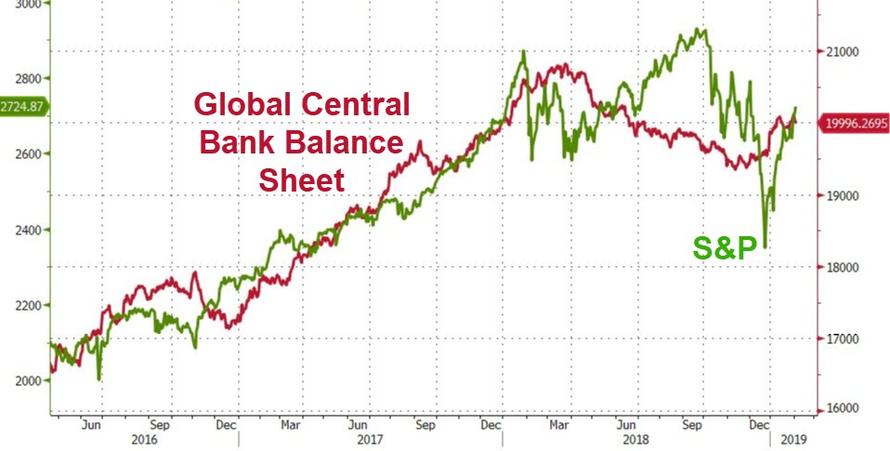“Stocks have reached a permanently high plateau”, “subprime is contained”, “there’s no icebergs this far south” and now “The Fed’s balance sheet is not the threat that people seem to think it is.”
Man’s ability to willfully ignore ‘downside possibilities’ and remain cognitively dissonant far longer than logic (or their pocketbook) should allow seems to know no bound and none other than The Federal Reserve’s Bill Dudley just unleashed what could be the piece de resistance of “nothing to see here, move along” agitprop.
Stop Worrying About the Fed’s Balance Sheet
It’s not the threat that people seem to think it is.
Financial types have long had a preoccupation: What will the Federal Reserve do with all the fixed income securities it purchased to help the U.S. economy recover from the last recession? The Fed’s efforts to shrink its holdings have been blamed for various ills, including December’s stock-market swoon. And any new nuance of policy — such as last week’s statement on “balance sheet normalization” — is seen as a really big deal.
I’m amazed and baffled by this. It gets much more attention than it deserves.
Let’s start with the stock market. Yes, it’s true that stock prices declined at a time when the Fed was allowing its holdings of Treasury and mortgage-backed securities to run off at a rate of up to $50 billion a month. But the balance sheet contraction had been underway for more than a year, without any modifications or mid-course corrections. Thus, this should have been fully discounted.
Moreover, if anything, the run-off of the Fed’s balance sheet had a smaller-than-expected impact on the yields of those securities. Longer-term Treasury yields remained low, and the spread between them and the yields on agency mortgage-backed securities didn’t change much. It’s hard to see how the normalization of the Fed’s balance sheet tightened financial conditions in a way that would have weighed significantly on stock prices.
Better explanations for this fall’s weakness in the equity market abound. For one, economic growth and corporate profits looked set to falter in 2019, as the effects of corporate tax cuts waned and the labor market tightened. Demand for scarce labor should increase its share of income, crimping profits. And if the economy didn’t slow enough on its own, the Fed was likely to raise interest rates to make sure that happened. These developments weren’t good for an equity market that had been accustomed to strong earnings growth and an accommodative central bank.
Why then, one might ask, did the Fed announce changes to its plans to pare down its holdings of Treasury and mortgage-backed securities? Actually, there wasn’t much of a change at all. Here’s what Chairman Jay Powell said at his news conference last week:
The Fed will maintain a balance sheet big enough to satisfy banks’ demand for reserves, with a buffer above that so the Fed will not have to intervene in the money markets on a day-to-day basis;
The Fed now expects banks to demand more reserves than previously thought, so its balance sheet will likely be larger — this means more securities in its portfolio;
The Fed could use its balance sheet more actively as a monetary policy tool but only if interest-rate adjustments — its primary tool — were to prove inadequate.
None of this should be a surprise. It always was likely that the Fed would maintain the current “floor” system, in which its choice of the interest rate it pays on reserves drives monetary policy. It also has been clear that banks would have a greater demand for reserves than in prior expansions. That’s because the central bank now pays interest on those reserves, and post-crisis regulations require banks to keep a lot more cash and other liquid assets on hand.
The new news here is simply that Fed sees greater demand for reserves than it expected a year ago. But even this should not be a big surprise. After all, the federal funds rate — the interest rate that banks pay to borrow reserves from one another — had crept up to equal the rate that the Fed itself pays on reserves. So the central bank’s conclusion is just consistent with what we have already seen happening in money markets.
The concept of using the balance sheet as a monetary-policy tool isn’t new, either. It has always been part of the Fed’s toolkit. The shift is merely in emphasis. When the Fed was clearly on a tightening path, the attention was on interest rates. The Fed has made it clear that this is the primary tool of monetary policy and that hasn’t changed a whit. However, now that the balance sheet is getting more attention and the direction of short-term interest rates is less certain, the Fed is simply reminding people that the balance sheet is still available in circumstances where its primary tool might be insufficient.
We are nowhere close to that situation today. The balance sheet tool becomes relevant only if the economy falters badly and the Fed needs more ammunition.
It’s worth pointing out that the composition of the balance sheet is also important. Not only does it matter how much the Fed holds in Treasury and mortgage-backed securities, but also — for Treasury securities — whether they are predominately short-term bills, medium-term notes or long-term bonds.
On this score, the Fed faces several important decisions. First, once the balance sheet gets to the desired size, what will it do with its still-large holdings of mortgage-backed securities? Will it just let them run off passively, or more actively sell them off? Under a passive approach, it would take several decades for the holdings to disappear.
Second, on the Treasury side, what should the composition be? Before the crisis, the Fed held Treasury securities across the maturity spectrum. Now, with a much bigger balance sheet, there is more reason to shift to Treasury bills. Holding mostly bills would reduce exposure to interest rate risk and increase the firepower available to fight future economic downturns. Should quantitative easing be needed, the Fed would have greater scope to extend the maturities of its holdings, not just increase the size of its balance sheet.
The bottom line: The Fed’s balance sheet isn’t the threat that market participants sometimes make it out to be, and last week’s announcements do not have significant implications for the interest rate outlook. Market participants would be better off focusing on the economic outlook. This is what will drive monetary policy and the Fed’s decisions about the appropriate trajectory for short-term interest rates over the next year. If the outlook changes, so will the Fed’s thinking.
* * *
So, feel any better? Still worried about the $4 trillion balance sheet’s affect on global markets? We have two quick questions for Mr.Dudley that should help clear things up:
1) When the balance sheet is expanding, your privy council proclaimed it all-powerful in its omnipotent role of wealth-creation through asset-value-levitation – So, why do you consider the unwind of this massive monetary experiment a ‘nothingburger’?
2) If the unwind of this experiment is ‘nothing’, why did the market shit-the-bed when Powell said ‘auto-pilot… lot smaller’ and why did The Fed just perform the greatest U-turn in policy in its history?
Probably nothing, right, Mr. Dudley?
via ZeroHedge News http://bit.ly/2DffjPc Tyler Durden

